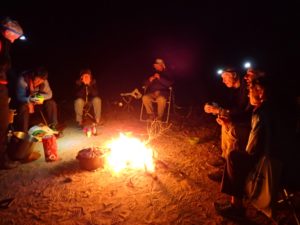Epilogue
If you are one of my friends or family that contributed to my effort to finance at least 10 Buffalo Bikes for some people in Africa, you may be interested in this story. I was able to meet a Buffalo Bike owner and see for myself how they can make a difference in someone’s life.
When I first decided to go to Africa one of the first thoughts to cross my mind was that I was going to be riding through some places where most people struggle to exist every day. Riding in similar places and seeing how in such places, a simple thing, such as a bicycle, could totally change lives. Originally, I was thinking about fixing up a couple of bikes and taking them with me but when I began to look at what would be involved, I realized that doing it that way was far too complicated and loaded with other roadblocks.
Since it is well known how important bicycles are in Third World countries, I began to suspect that there were already organizations doing on a larger scale what I had contemplated as an individual. A brief search uncovered a number of them but the one that stood out was World Bicycle Relief. That organization was founded in 2005 by F.K. Day and Leah Missbach Day in response to the Indian Ocean tsunami. F.K. Day is one of the founders of SRAM, a major manufacturer of bicycle components and an innovator in that field. I figured that if anyone could approach the problem of getting good, durable bicycles to places in the world where they were needed, it would be someone who really understood bicycles. Further investigation proved to me that World Bicycle Relief had an excellent model for doing this in a sustainable way and for being an organization that put nearly all the money they raised through donations into results rather than into marketing and executive salaries.
Through them I learned about the Buffalo Bike, a purpose built bike designed to be strong, easily adaptable for a variety of uses and easy to repair and maintain. Best of all, World Bicycle Relief did not just build a bunch of bikes and give them away, they also created the infrastructure to maintain them and used local workers in the process of building the bikes and distributing them. For every $205 (Canadian) that I could raise, a brand-new Buffalo Bike would find its way to someone who’s life it could change. During my first day of riding in Zambia, I was able to witness this in action.
As I was riding towards the border with Botswana, I passed a young man riding a Buffalo Bike with a large milk can attached to the rear rack. Along the way two others with the exact same set up joined him. We rode together for over an hour and I was able to talk with the one rider who was as much interested in what I was doing as I was with him. I wanted to take his picture but discovered that my newly unpacked camera lacked its battery. Fortunately, I found a story online about how the milk co-operative he was part of used the Buffalo Bike to create a dairy industry in that impoverished part of Zambia. I also found this picture on the Internet of the guy I was riding with.
Small farmers in this area usually only have a few cows or goats that they milk by hand. None are large enough to afford a motor vehicle and the dirt tracks that access their land are not suitable for any truck-based collection system. Each farmer only produces a small amount of milk, maybe enough to fill a 40 L (10 gal.) milk can every day or so. They need to get it to a collection site before it goes bad. It is here that the Buffalo Bike comes into play. The milk co-operative gives the Buffalo Bikes to the farmers who either load the full, 45 kg (100 pound) container onto the back and pedal it themselves to the collection station or have one of their older children do it. Sometimes young men from the community can earn an income by becoming dedicated delivery riders for this purpose. My conversation with one of the young men that I rode with left me with the impression that he was working full time as a two wheel, delivery rider. The farmers sell this milk at the co-operative and receive hard currency that they can use to purchase things that improve their lives. The bike can also be used for other things such as getting to a doctor or to transport a child to school.
The young man I rode with was part of a group of four or five who were making their way to the raw milk collection point that day. They all rode Buffalo Bikes and each carried the large milk can strapped to the heavy duty rear rack, the same as shown in the picture below. We passed each other a number of times during the two-hour window during which I encountered them as I was making my way to our lunch stop just this side of the Botswanan border crossing. With their heavy load and my better gearing, I was easily able to outdistance them going uphill. However, their younger legs and stamina allowed them to easily catch up on the flats. It was quite the experience to see something that my friends and I helped to support being used under real world conditions and to see how a Buffalo Bike changes a life. While I had to cut my ride short, the good work done by the bikes my friends, family and I helped to purchase will continue to pay dividends long after my wheel tracks have disappeared. Thanks to everyone donated and if you would still like to do so, here is the link: powerofbicycles.org/fundraisers/bobpeltzer





















